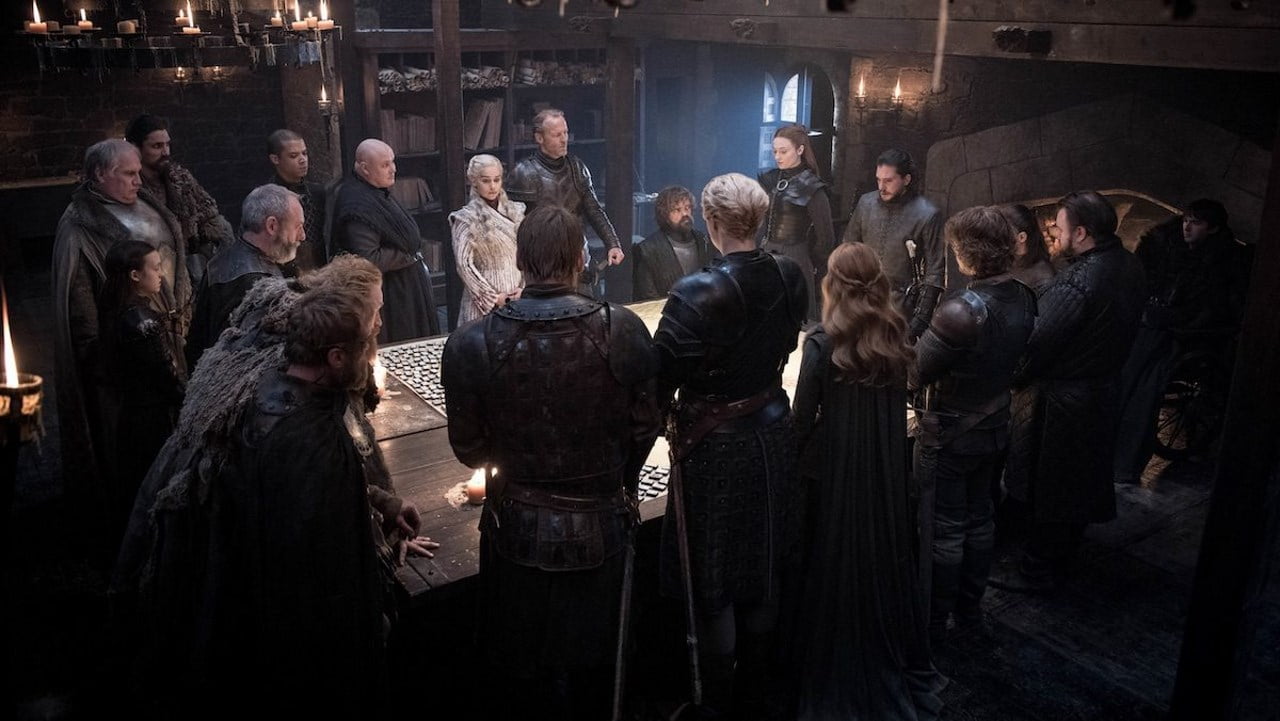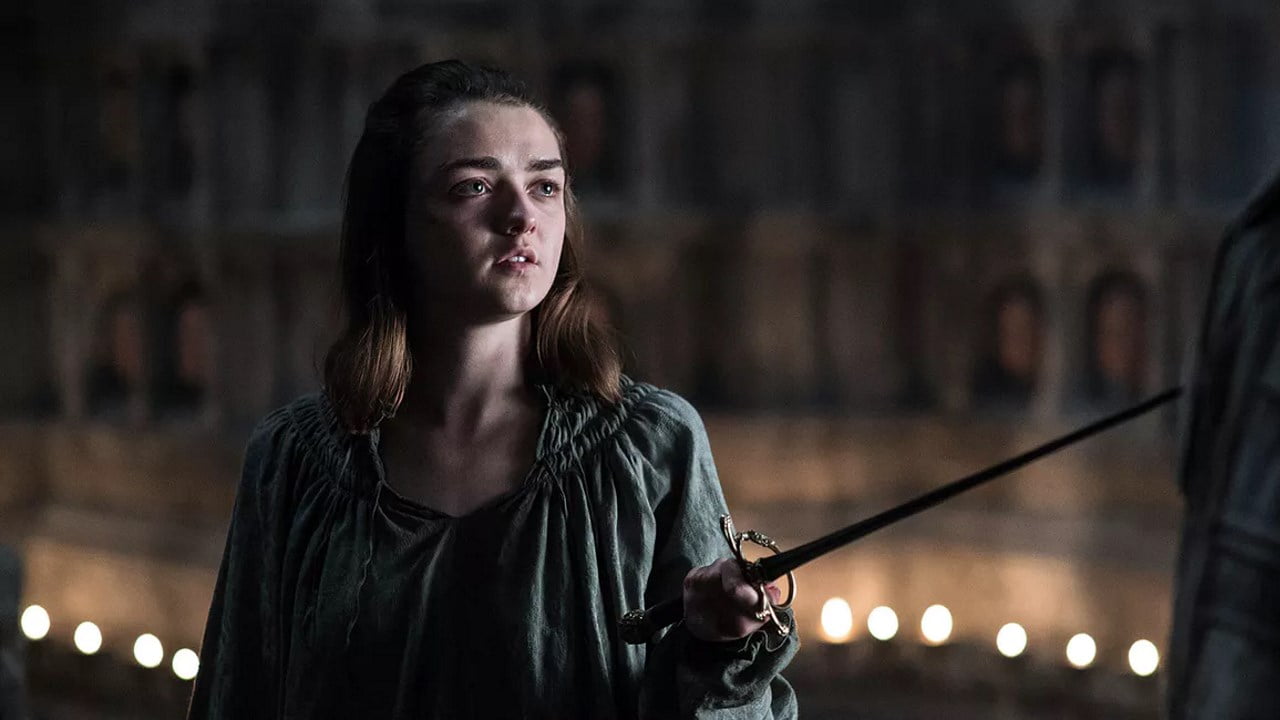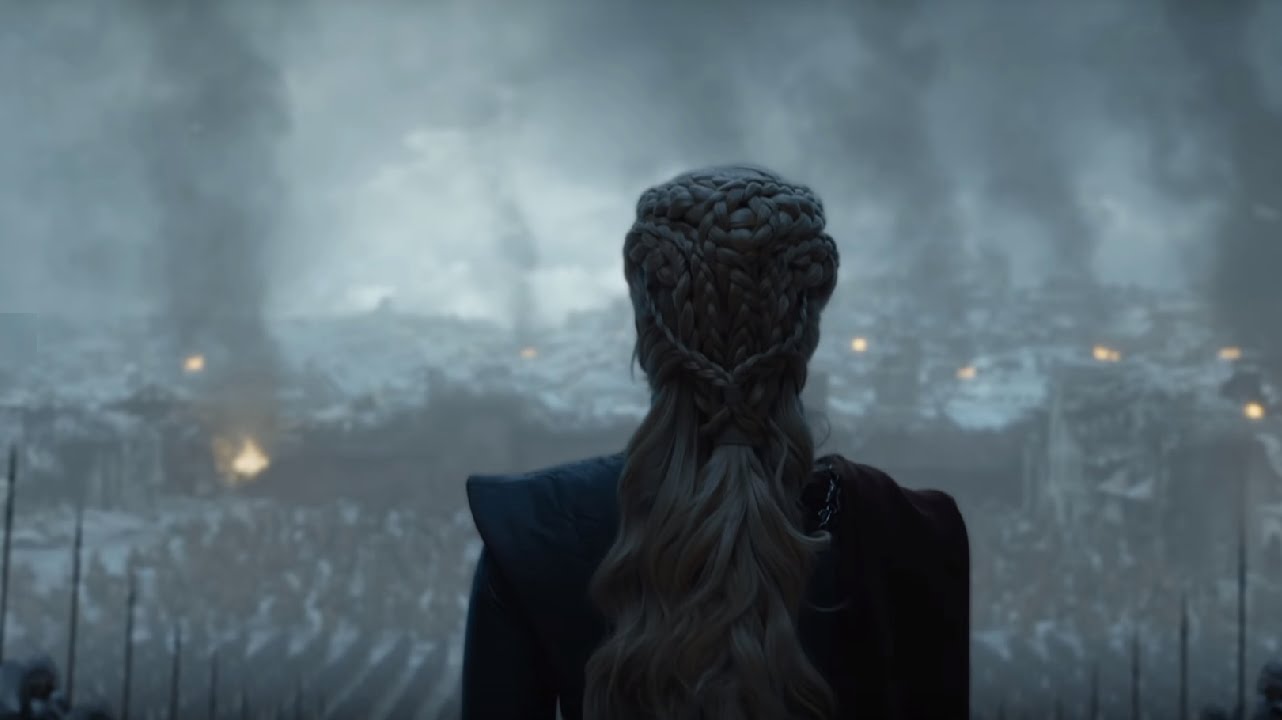From Dark Souls to ludonarrative dissonance, Game of Thrones feels a lot like a video game in its final season.
For years, video games have been apeing film and television. We ran an entire column dedicated to the intersection of video game and film for six months.
As video games sought greater respect for the art form, like a try-hard kid trying to get in with an older, cooler crowd, the osmosis from TV and film was inevitable.
The funny thing about osmosis, though, is that sometimes things flow both ways. And while television and film have been visibly shaping storytelling and cinematography in video games, we’re also starting to see the inverse. We find it in the blurred reality scene-setting and GTA-alike roleplaying in HBO’s Westworld. It’s in the respawn conceit in everything from Hollywood’s Source Code and Edge of Tomorrow to Netflix’s Altered Carbon and Russian Doll.
And now, in its eighth and final season, video game influences have taken over in Game of Thrones.
Warning: There are spoilers for Game of Thrones – in particular, the final season – below.
Crafting
Nobody just buys anything in video games any more. In an effort to eke out more play time through repetitive tasks, shopping has been replaced with crafting.
“Get money, go shopping, buy thing” becomes “complete quest, get blueprint or recipe, hunt for components, travel to safe location, craft thing” instead. It feels counter-capitalist at first, like a video game version of The Good Life (with less Felicity Kendal). But in reality? It means wasting huge gobs of your free time to pillage the virtual environment to make a new pair of boots out of the carcases of 100 dead otters.
In Game of Thrones, they’re mostly crafting Dragonglass weapons to take on the army of the dead. It gives Gendry a chance to show off his blacksmithing skills, at least. Oh, and Cersei has been busy living her best Age of Empires fantasies, crafting some very big catapults.
The BioWare Effect
There’s a moment, in video games, that happens just before the end. It’s particularly prevalent in large scale RPGs with lots of party members, like Dragon Age or Final Fantasy: All of the heroes will gather together for a chat.

It’s basically the point of no return. It’s where the game gives you a chance to make sure you’ve levelled up your characters, kitted them out properly, and completed all the optional side quests. Because once you cross that threshold, you’re not coming back.
In the final season of Game of Thrones, the whole of the second episode was one big BioWare moment. Heroes from all over were reuniting, planning, laughing, drinking, dancing, and fornicating, like it was their last night alive. Like Mass Effect 2’s infamous suicide mission, it felt like nobody was coming back from this one.
Some of them sadly didn’t.
(HIS NAME WAS BERIC DONDARRION, GODDAMIT. HE WAS A HERO AND YOU ALL DON’T EVEN REMEMBER HIS NAME. BERIC DONDARRION. NOT “EYE PATCH MAN,” OR “SHERIFF DAN ANDERSEN FROM FORTITUDE” – SHOW A LITTLE RESPECT.)

Tower defence
The final season’s third episode, The Long Night – colloquially known as the Battle of Winterfell – is equal parts tower defence and Helm’s Deep from Lord of the Rings. Not one of those nice tower defence games like Plants vs. Zombies, either. One of those horrible tower defence sequences, from Gears of War, or Resident Evil, or World War Z.
After time to set your defences, first, there comes silence. Agonising, interminable silence, deep and dark enough to drown in. Then the first wave crashes against your fortifications. You repel it, perhaps fall back to a deeper defensive position, then steel yourself for another attack.
This repeats for the duration of the battle. But on the defending team, you don’t know how many phases you need to repel. Just when you think you’re surviving, the enemy summons up new forces out of nowhere. (Literally. Whoever thought hiding from a necromancer god in a crypt was a good idea?)
All you can do is keep fighting, and hope this is a sequence you’re able to win.
Fog of War
It’s a bit of a cheap trick, but the Night King creates a swirl of storm clouds in the skies around Winterfell. This serves several purposes. It blots out any moonlight, so Winterfell’s defenders can’t see. It presumably also scares the crap out of people.
But it also masks his position, as he soars above the castle on the zombified dragon, Viserion. While Danaerys and Jon try and engage him, it gives the Night King the element of surprise.
Classic Fog of War usage. (And it’s a bonus if distance fog means Game of Thrones can save on CGI budget by not rendering things more than 50 yards away. Pop-in for the win.)
Insta-fail stealth
While the Battle of Winterfell rages outside, Arya finds herself trapped in the castle’s library. Here the undead horde of the Night King – so often raging and racing, firmly from the fast zombie trope – shamble around, sentry-like, among the bookcases.
Arya can take out one or two, but any amount of noise will bring more wights down on her. So she sneaks, Solid Snake style, through the library. She skulks in the shadows. She avoids their cone of vision. She waits for them to pass. She doesn’t make a sound. Arya even borrows a page out of Joel and Ellie’s playbook, throwing objects into other parts of the room to distract them.
Then, as it always does with stealth sections, something goes wrong. Wights begin to pour into the library and Arya is left with no choice but to fight her way out. If that doesn’t perfectly encapsulate everything that’s frustrating about lengthy insta-fail stealth sections, then nothing does.

Then Sandor and your man Beric Dondarrion arrive to back her up, and ultimately, help the young Stark fulfil her destiny.
Grinding for XP
When Arya killed the Night King at the end of the Battle of Winterfell, people cried foul, claimed her to be a Mary Sue. People thought it should’ve been Jon. Even Maisie Williams said her boyfriend thought it should’ve been Jon.
Taking aside for a moment that this probably comes down to sexism, by and large, lots of people seem to have forgotten what a Mary Sue is. (In the same way that people accuse any article they don’t like of being clickbait, any heroic woman they don’t like in a movie or TV show is mislabelled as a Mary Sue.)
According to Wikipedia, a “Mary Sue is an idealized and seemingly perfect fictional character… [who can] can usually perform better at tasks than should be possible given the amount of training or experience.”
Now just let that sink in for a moment. “… given the amount of training or experience.”
Yes, Jon’s a soldier and a fighter. Yes, he’s the former Lord Commander of the Night’s Watch. And yes, he’s probably a foot taller and 40 kilos heavier than Arya (though not exactly strapping compared to the likes of Sandor Cleghane and Tormund Giantsbane).
But while Jon has been faffing about with Wildlings and romancing his aunt and accidentally playing the game of thrones, even though he doesn’t want it, what has Arya been doing? Travelling. Training. Learning. Grinding for experience points. Learning to be a girl with no name, a girl with many faces, an assassin of the House of Black and White. While everyone else has been doing their day job, she has just been grinding XP. Constantly. For seven seasons.

She took down several soldiers and Ser Meryn Trant, former head of the King’s Guard. She killed the Waif, another faceless assassin sent to dispatch her. She butchered Walder Frey’s sons, then fed them to him in a pie (before murdering him and poisoning every member of his family). Then she bested Brienne of Tarth in training and executed Petyr “Littlefinger” Baelish, possibly on the same day.
So why, after that trail of death and destruction, isn’t the diminutive assassin the right person to kill the Night King, as foretold in Melisandre’s prophecy?
If you’re still not convinced, consider this: When Game of Thrones started, all of the characters – even the northerners – were supposed to speak with received pronunciation accents. When Sean Bean couldn’t, it meant every single northern character needed to speak with something approximating a Sheffield accent, so Bean didn’t stand out.
On the other hand, when Maisie Williams took the role of Arya, she learned how to do everything – from writing to sword fighting – with her left hand. Why? Because in the books, the character is left-handed, and she wanted to get it right. And the knife flip trick, that she first practised against Brienne before using it to kill the Night King? Maisie Williams learned how to do that in real life.
Grinding for XP works, folks, and Maisie Williams and Arya Stark are both badasses.
Fridging
This isn’t specifically a video game trope – in fact, it’s named after the Green Lantern comic book, where the hero’s dead girlfriend is literally left in a fridge for him to find – but it is particularly prevalent in the medium. The Last of Us. Max Payne. Days Gone. Final Fantasy – various. Castlevania – various. Phantasy Star – various. Grand Theft Auto – various. Saints Row – various. Look, we could go around all day on that. There are so many instances of family or friends, usually female, dying (or already being dead) just to provide the hero with some motivation.
Deaths aren’t necessarily a bad thing. One of the great things about Game of Thrones is that nobody – literally, nobody – has plot armour. Everyone is fair game and it keeps things interesting. But the death of Missandei of Narth at the end of the fourth episode? It serves a very specific purpose: to galvanise Dany’s resolve to smite everyone in her way, guilty or innocent. It also motivates Grey Worm for a vengeful rampage when the smiting begins.
Dark Souls
Fans of Game of Thrones have been looking forward to The Cleganebowl for years. While Sandor ‘The Hound’ Clegane hates his brother – for burning his face in a fire as a child – Gregor ‘The Mountain’ Clegane just hates everyone. And then he got killed and was zombified by creepy weirdo Qyburn, which didn’t help his demeanour much.
Sandor also hates the Lannisters. And given Cersei’s habit of sending ‘The Mountain’ into trial by combat when she finds herself in bother (aside from that time she blew everyone up), it seemed feasible that Sandor and Gregor might end up facing off in an arena before the show’s end. That’s the bloke off the Scott’s Porage Oats advert against the World’s Strongest Man, by the way. Let that slightly bonkers image sink in for a moment.
When the attack on King’s Landing begins in episode five, Sandor and Arya move to the Red Keep with different goals. His, to kill his brother. Hers, to kill Cersei. As the keep falls down around their ears, wreathed in smoke and flame, Sandor persuades Arya to put her own self-interest above her list of vengeance for once and escape the rubble, before heading off to face his demon.
The ensuing battle is… a bit of a letdown, after seven years of anticipation. Well, aside from the bit where Cersei apologetically tiptoes past the brothers, like she’s guiltily squeezing past people to go to the bathroom in a packed movie theatre. That was hilarious.
One thing that struck me watching Game of Thrones this weekend was how much this shot just looks like what I'd imagine a Dark Souls movie adaptation would look like pic.twitter.com/tXjtRpN8zr
— Nick Horowitz (@ztiworoh) May 14, 2019
But what we do get is just a glimpse of Dark Souls in George R R Martin’s universe. From the size difference of the protagonist and the boss monster – because Sandor is a hero of sorts, and we all grew to love him, in the end – to Gregor losing his armour the more damage he receives, to his lumbering attack patterns and grotesque appearance, everything about this screams Dark Souls.
Ludonarrative dissonance
Ludonarrative dissonance is a term that describes when the ludology (your actions, delivered through gameplay) and the narrative (the story) of a video game clash. Originally coined by Clint Hocking while writing about BioShock – on how the self-interest of the player’s actions conflicts with the selflessness of its narrative – the term has been used since to describe the abrasive shock when your actions, in direct contrast to the game’s narrative, pull you out of the experience.
See also: That bit in Final Fantasy VII where the player almost kills Aerith because the only button they can press brings Cloud’s sword closer to her head. And the thing with the white phosphorus in Spec Ops: The Line. Or pretty much every character in a Rockstar game, from Grand Theft Auto: San Andreas (where CJ wants to clean up the streets of gangland crime by, erm, forcing the player to become the biggest gang) to Red Dead Redemption 2 (where the Van Der Linde gang hope for a quiet life by, erm, making the player do a lot of crimes and murder). There’s even an achievement named after it in Uncharted 4: A Thief’s End, when happy-go-lucky scoundrel Nathan Drake has killed over a thousand people. Again, we could go on all day on this one.
Game of Thrones isn’t a video game, so you could argue that ludonarrative dissonance can’t apply here. But given the length of time we’ve spent with its characters – and just how shocked everyone seems to be at Dany’s actions in the fifth episode of its final season – it’s probably closer to the mark than you might think.

We’ve been rooting for Daenerys Targaryen from the first season of Game of Thrones. In contrast with her vain, egotistical brother, Viserys, she seems like a worthy ruler. And as Varys reminds us before his demise: “Every time a new Targaryen is born, the gods toss the coin in the air and the world holds its breath to see how it will land.”
The implication is that, like Cersei Lannister’s incestuous children, there’s a fifty-fifty chance that they will be either benevolent or tyrannical. The inference we all made was was that because Viserys was bad, then probability dictates that Dany is good.
But you can toss a coin 10, or 50, or even 100 times and get the same result each time. The probability is tiny, but it can happen. Just ask the Lutece twins. (Or for a real-world example, Derren Brown.) We were wrong to assume that because the probability of Targaryen madness is binary, and that because Viserys was bad, then Dany must be good.
You can argue all you want that her descent into madness was too swift. That we took too direct a route in the show’s haste to wrap up all the loose ends in just six episodes. The heel-turn is rightly a point of contention. But the path to madness and tyranny? That’s been foreshadowed for some time.
When she freed the slaves, it was absolutely the right thing to do, but it was a calculated decision. Dany didn’t free the slaves so they were free. She freed them so they would become her army. She’s since been ransacking, crucifying, and burning her way across Essos for the first six seasons, and if anyone hasn’t bent to her will, she’s threatened to burn their armies and cities to the ground. Only her advisers and confidants, the likes of Ser Jorah and Ser Barristan, Missandei and Varys, have stayed her fury. But they’re all gone now, and since finding out someone has a more legitimate claim to the Iron Throne than her? That paranoia has accelerated her descent into madness.
Another core of George R R Martin’s stories – in addition to the lack of plot armour – is that the only people who actively seek to rule are either tyrants, mad, or some combination of the two. The signs have been there all along, but we were so wrapped up in the narrative we’d been fed, that she was the hero of the story, that we didn’t notice the darkness in her actions. In her ludology. In how she played the game of thrones.
Maybe if the showrunners had included a glass shattering montage – like the “Keyser Soze” moment in The Usual Suspects or BioShock’s “Would you kindly?” reveal – of all the times she showed signs of madness and tyranny, people might have found it easier to accept. The signs were all there. The foreshadowing was on the wall.
But perhaps if you think of it less as standalone storytelling, and with our investment in Game of Thrones and its characters, something more akin to ludonarrative dissonance? It makes more sense.
And if you still don’t see it? You probably still thought Walter White was a good guy by the end of Breaking Bad. Just saying.






